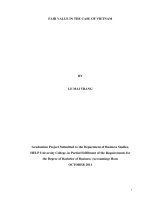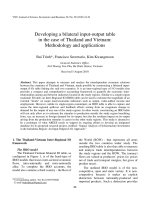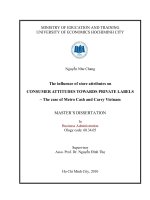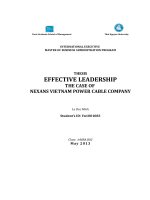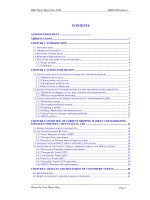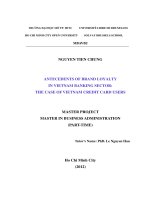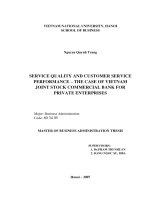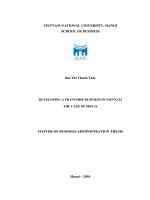effective leadership the case of nexans vietnam power cable company
Bạn đang xem bản rút gọn của tài liệu. Xem và tải ngay bản đầy đủ của tài liệu tại đây (1.07 MB, 94 trang )
Paris Graduate School of Management Thai Nguyen University
INTERNATIONAL EXECUTIVE
MASTER OF BUSINESS ADMINISTRATION PROGRAM
THESIS
EFFECTIVE LEADERSHIP
THE CASE OF
NEXANS VIETNAM POWER CABLE COMPANY
Le Duc Minh
Student’s ID: Vn1001083
Class: ieMBA.B02
May 2013
Effective Leadership Le Duc Minh – IeMBA-B02
COMMITMENTS
I guarantee that the contents of this thesis have never been submitted to any master
program or other programs.
In addition, I am committed that this thesis presents my own efforts. All analysis
outputs and conclusion included (apart from quoted contents) are results of my
research.
Research student
Le Duc Minh
i
Effective Leadership Le Duc Minh – IeMBA-B02
ACKNOWLEDGEMENTS
First and foremost, I would like to express my sincerest thanks to my instructor –
Doctor Dang Ngoc Su – for his dedicated and enthusiastic instruction to the
completion of this thesis. But for Doctor Dang Ngoc Su’s help, my thesis would
not have been completed.
Besides, I am grateful to leaders, managers and lecturers of PGSM program and
Thai Nguyen University for their facilitation and support in my MBA course as well
as research process and thesis formation.
In addition, I would like to acknowledge leaders and colleagues at Nexans Vietnam
Power Cable Company who give me their enthusiastic and impartial support in my
data collection process by spending their precious time and putting efforts in
meeting me and completing survey questionnaire.
Particularly, I would like to thank all beloved members in my family including my
kind old parents, my beloved wife, daughter and son as well as my older brothers
and sisters for their support and affiliation for my completion of the program and
this thesis.
ii
Effective Leadership Le Duc Minh – IeMBA-B02
TABLE OF CONTENTS
1.1. Concept, nature and significance of leadership 4
1.1.1 Concept and nature of leadership 4
1.1.2 Role and importance of leader 6
CHAPTER II 29
LEADERSHIP IN REALITY 29
AT NEXANS VIETNAM CABLE POWER COMPANY 29
2.1 Introduction to Nexans Vietnam Power Cable Company 29
Core capacity 31
Nexans Vietnam Power Cable Company (NPVC) is the leading company in
aluminum rod, high quality power cables with aluminum and aluminum alloy
conductors in accordance with international standards. During over 15 years of
formation and development, the Company has gained a lot of experiences and
knowhow in production of power cables with active and professional officers and
employees trained oversea. It has established its unique culture. All play as a firm
foundation for sustainable development of NVPC that cannot found in other
companies in the industry 31
2.1.2 Organizational structure 31
2.2 Current situation of leadership in Nexans Vietnam Power Cable Company 33
2.2.1 Old organizational model 33
2.2.2 New organizational model since 2010 36
2.2.3 Human resources 38
2.3. Assessment of leadership in the company 40
2.3.1. Vision 40
2.3.2. Decentralization, authorization 48
2.3.3. Motivation, encouragement 52
2.3.4. Influence 56
2.3.5. Leadership communication 59
2.3.6. Decision making 61
2.3.7 Self-understanding - understanding others 63
2.4. A summary of achievements and shortcomings 66
Conclusion to Chapter II 70
CHAPTER III 71
SOME SOLUTIONS TO IMPROVEMENT OF LEADERSHIP EFFECTIVENESS IN
NEXANS VIETNAM POWER CABLE COMPANY (NVPC) 71
3.1 Develop vision 71
3.2 Exploit employees’ psychology factor 73
3.4 Maintain and develop competitive human resources 76
iii
Effective Leadership Le Duc Minh – IeMBA-B02
LIST OF ABBREVIATIONS
English English
NVPC Nexans Vietnam Power Cable Company
AAC All Aluminum Conductor
ACSR Aluminum Conductor Steel Reinforced
AACSR Aluminum Alloy Conductor Steel Reinforced
AAAC All Aluminum Alloy Conductor
ABC Arial Bundled Cables
ACAR Aluminum Conductor Alloy Reinforced
iv
Effective Leadership Le Duc Minh – IeMBA-B02
LIST OF TABLES
Table 1.1: Concepts of leadership Error: Reference source not found
1.1. Concept, nature and significance of leadership 4
1.1.1 Concept and nature of leadership 4
1.1.2 Role and importance of leader 6
CHAPTER II 29
LEADERSHIP IN REALITY 29
AT NEXANS VIETNAM CABLE POWER COMPANY 29
2.1 Introduction to Nexans Vietnam Power Cable Company 29
Core capacity 31
Nexans Vietnam Power Cable Company (NPVC) is the leading company in
aluminum rod, high quality power cables with aluminum and aluminum alloy
conductors in accordance with international standards. During over 15 years of
formation and development, the Company has gained a lot of experiences and
knowhow in production of power cables with active and professional officers and
employees trained oversea. It has established its unique culture. All play as a firm
foundation for sustainable development of NVPC that cannot found in other
companies in the industry 31
2.1.2 Organizational structure 31
2.2 Current situation of leadership in Nexans Vietnam Power Cable Company 33
2.2.1 Old organizational model 33
2.2.1 Old organizational model 33
2.2.2 New organizational model since 2010 36
2.2.2 New organizational model since 2010 36
2.2.3 Human resources 38
2.2.3 Human resources 38
2.3. Assessment of leadership in the company 40
2.3.1. Vision 40
2.3.1. Vision 40
2.3.2. Decentralization, authorization 48
2.3.2. Decentralization, authorization 48
2.3.3. Motivation, encouragement 52
2.3.3. Motivation, encouragement 52
2.3.4. Influence 56
2.3.4. Influence 56
2.3.5. Leadership communication 59
2.3.5. Leadership communication 59
2.3.6. Decision making 61
2.3.6. Decision making 61
2.3.7 Self-understanding - understanding others 63
2.3.7 Self-understanding - understanding others 63
2.4. A summary of achievements and shortcomings 66
Conclusion to Chapter II 70
CHAPTER III 71
v
Effective Leadership Le Duc Minh – IeMBA-B02
SOME SOLUTIONS TO IMPROVEMENT OF LEADERSHIP EFFECTIVENESS IN
NEXANS VIETNAM POWER CABLE COMPANY (NVPC) 71
3.1 Develop vision 71
3.2 Exploit employees’ psychology factor 73
3.4 Maintain and develop competitive human resources 76
Table 1.3: Comparison of approaches to leadership Error: Reference source not
found
Table 2.1. Production and business outputs of NVPC during the past several years
Error: Reference source not found
Table 2.2 Statistics on quantity and quality of human resources in the company
Error: Reference source not found
LIST OF FIGURES/GRAPHS
Figure 1.1: Effective leadership – Procedural approach
Figure 1.2: Behavior – Task based model in effective leadership
Figure 1.3: Effective leadership – Component approach
1.1. Concept, nature and significance of leadership 4
1.1.1 Concept and nature of leadership 4
1.1.2 Role and importance of leader 6
CHAPTER II 29
LEADERSHIP IN REALITY 29
AT NEXANS VIETNAM CABLE POWER COMPANY 29
2.1 Introduction to Nexans Vietnam Power Cable Company 29
Core capacity 31
Nexans Vietnam Power Cable Company (NPVC) is the leading company in
aluminum rod, high quality power cables with aluminum and aluminum alloy
conductors in accordance with international standards. During over 15 years of
formation and development, the Company has gained a lot of experiences and
knowhow in production of power cables with active and professional officers and
employees trained oversea. It has established its unique culture. All play as a firm
foundation for sustainable development of NVPC that cannot found in other
companies in the industry 31
2.1.2 Organizational structure 31
2.2 Current situation of leadership in Nexans Vietnam Power Cable Company 33
2.2.1 Old organizational model 33
2.2.1 Old organizational model 33
2.2.2 New organizational model since 2010 36
2.2.2 New organizational model since 2010 36
vi
Effective Leadership Le Duc Minh – IeMBA-B02
2.2.3 Human resources 38
2.2.3 Human resources 38
2.3. Assessment of leadership in the company 40
2.3.1. Vision 40
2.3.1. Vision 40
2.3.2. Decentralization, authorization 48
2.3.2. Decentralization, authorization 48
2.3.3. Motivation, encouragement 52
2.3.3. Motivation, encouragement 52
2.3.4. Influence 56
2.3.4. Influence 56
2.3.5. Leadership communication 59
2.3.5. Leadership communication 59
2.3.6. Decision making 61
2.3.6. Decision making 61
2.3.7 Self-understanding - understanding others 63
2.3.7 Self-understanding - understanding others 63
2.4. A summary of achievements and shortcomings 66
Conclusion to Chapter II 70
CHAPTER III 71
SOME SOLUTIONS TO IMPROVEMENT OF LEADERSHIP EFFECTIVENESS IN
NEXANS VIETNAM POWER CABLE COMPANY (NVPC) 71
3.1 Develop vision 71
3.2 Exploit employees’ psychology factor 73
3.4 Maintain and develop competitive human resources 76
vii
Effective Leadership Le Duc Minh – IeMBA-B02
PREFACE
Name of thesis: Effective Leadership – The case of Nexans Vietnam Power Cable
Company (NVPC)
1. Reason for choosing this thesis
In this changing context of “Flat world”, groups, companies and enterprises of all
sizes are facing increasingly fierce competition in all fields. With small size, limited
resources and modest experiences, corporations and enterprises of different sectors
in Vietnam are challenged. For the survival and development of Nexans Vietnam
Power Cables Company, leaders of the Company should respond to constant
changes in surrounding environment besides seeking a suitable and proper direction
for management to achieve set targets.
How can we achieve effective leadership? Getting influence to seek voluntary
participation of employees and create favorable conditions in order to achieve
targets in the short-run and long-run is demanded of leaders in the current changing
environment.
As a leader of the Company, I have chosen the thesis of “Effective leadership –
The case of Nexans Vietnam Power Cable Company” for graduation project. From
reality of the Company during the past years and development direction for the
years to come, and my knowledge, I choose this thesis in order to contribute more
to the sustainable development of the Company.
2. Research objectives
Applying learned theory and leadership skills, this thesis investigates and assesses
current situation of leadership in Nexans Vietnam Power Cable Company in
accordance with procedure, behavior – task factors and component; at the same
time it recommends solutions for improving leadership in Nexans Vietnam Power
Cable Company.
1
Effective Leadership Le Duc Minh – IeMBA-B02
3. Research Scope
The study just focuses on the leadership in Nexans Vietnam Power Cable Company
(NPVC).
4. Research methodology
- Qualitative method: Case study of Nexans Vietnam Power Cable Company
- Detailed method: Analysis, comparison and consolidation (Descriptive analysis)
- Data collecting method: Direct interviews, survey questionnaire.
- Data: Primary and secondary data are used in this study.
5. Significance
Theoretically, the thesis focuses on systematizing some common theories, skills and
styles of effective leadership in the world. Practically, the thesis analyses the
leadership in NVPC by using theories of leadership and effective leadership.
Additionally, the thesis may be used as a reference for other enterprises in the same
field.
6. Limits
This study is limited within Nexans Vietnam Power Cable Company. Therefore,
conclusions from the study should be applied for the Company only. Additional
study should be carried out if the study will be applied in other companies or other
types of business.
7. Thesis Structure
This thesis consists of preface, chapter I, chapter II, chapter III and a conclusion.
The preface reveals reason for choosing this thesis, research objectives,
methodology, significance and limitations.
Chapter I presents theoretical foundation, emphasizing nature and significance of
leadership, some approaches to leadership and international experiences in effective
leadership.
Chapter II gives an overview in the establishment and development, organizational
structure, operation, production and business outputs of the Company during the
recent years. It also assesses current situation of leadership of the Company, in
2
Effective Leadership Le Duc Minh – IeMBA-B02
which it deeply analyzes leadership effectiveness in fields of good performance and
works out limitations and shortcomings that need solving for the improvement of
leadership effectiveness in the future.
Chapter III recommends solutions to such limitations and shortcomings stated
above in Chapter II.
The conclusion summarizes all contents in the thesis, points out contributions and
limitations, opens new projects in effective leadership for deeper studies.
CHAPTER I: THEORETICAL FOUNDATION
3
Effective Leadership Le Duc Minh – IeMBA-B02
1.1. Concept, nature and significance of leadership
1.1.1 Concept and nature of leadership
The topic of “leadership” has long drawn the attention from scholars as well as
studies. In mentioning such concept, it commonly refers to powerful and active
individuals who can have influences on others and establish future for their
countries. History has proved influence extent and scale of “leadership” in many
fields such as religion, politics or military. It is not accidental when all Vietnamese
people admire and learn from President Ho Chi Minh – the old Father of the Nation,
the distinguished leader of Vietnam. In the world, eminent leaders such as
Mohammed, Mao Zedong and talented military experts such as Julius Ceasar,
Charles the Great (Charlemagne) or Alexander the Great built powerful empires.
Even Adolf Hitler can be seen as a “unique” leader with his strong power. For
enterprises, many excellent leaders are socially recognized as Bill Gates (Microsoft
–USA), Steve Jobs (Apple –USA), Akio Morita (Sony – Japan). They are typical
leaders with visions and qualities in exploiting potentials of people for successful
missions of their organizations.
Although the term of leadership had been in use for long time, it was until the 20
th
century, the concept of leadership received attention and discussion from scholars.
Researchers usually define leadership in accordance with their private concepts and
aspects that draw their attention most. The definition of Leadership may be
approached in such different angles as quality, behavior, influence or manner in
communication (Table 1.1).
As such, leadership is stated in different angles such as quality, behavior, influence
or simply the direction. According to Richard and Engle (1986) leadership is a
process of combining, articulating visions, embodying values and creating suitable
environment. While Richard J. Daft (1999) stated that leadership is the process of
creating influence between leaders and employees, which makes changes towards
common goals of the organization. In the book “Culture, Leadership, and
Organizations: The GLOBE Study of 62 Societies” published in 2004, House et al.
4
Effective Leadership Le Duc Minh – IeMBA-B02
defined leadership as the ability of an individual in creating influence and
encouragement for attracting the highest contribution from followers for the
development of an organization.
Table 1.1: Concepts of leadership
No. Concepts
1 Leadership is the behavior of an individual when he is directing the activities
of a group towards a shared goal (Hamphill & Coons, 1957)
2 Leadership is the influential increment over and above mechanical
compliance with the routine directives of the organization (D. Katz & Kahn,
1978)
3 Leadership is the process of influencing the activities of an organized group
toward goal achievement (Rauch & Behling, 1984)
4 Leadership is a process of shaping goals to reach through collective efforts
(Jacobs & Jaques 1990)
5 Leadership is the ability of overcoming existing culture to begin
revolutionary but appropriate changes (E.H. Schein, 1992)
6 Leadership is the process in which individuals in an organization feel what
they are doing and they will understand and commit what they will do (Drath
& Palus, 1994).
7 Leadership is about articulating visions, core values and creating the
environment within which things can be accomplished (Richards & Engles,
1986)
8 Leadership involves the ability of an individual in having influence and
encouraging his deputies to make their contribution to success of the
organization (House et al., 1999).
Besides the above-mentioned concepts, scholar Warren Bennis (2002) presented a
quite comprehensive but sufficient concept of leadership.
Bennis described leadership as a social process of influence in seeking participation
of followers for best implementation of targets of an organization. Also the author
emphasized the significance of follower participation in implementing missions of
an organization and responsibilities of leaders as the search of such participation.
5
Effective Leadership Le Duc Minh – IeMBA-B02
Success of companies and organizations is gained when and only when companies
and organizations receive voluntary contribution from employees. Therefore, the
social process of influence is the process that thoroughly combines methods of
influence such as mental and material methods, direct and indirect methods, formal
and informal methods, helps leaders to concentrate efforts and intelligence of
people. In addition, Yukl (2002) stated that leadership should be defined in a
broader concept. It should include factors that form collective efforts from members
of an organization or a group of people in order to accomplish set goals.
Therefore, the concept of leadership is understood as a social process in which the
leader is seeking voluntary participation of followers for success of the
organization. In other viewpoints, such concept implies the procedure of having
influence and creating environment to reach common goal of the organization.
So what is the nature of “leadership”? In Peter F. Drucker’s opinion, “leadership
art” involves not only the ability of attracting others but also the demagoguism.
Moreover, it is not only the ability of persuasion but also skills of sale executives.
1.1.2 Role and importance of leader
Leader and leader’s capacity prove significance and play crucial role in success of
any companies. A company without a capable leader is like a fighting unit without
its commander or a ship in difficult situation without a brave and wise captain.
Therefore, for success in the short-run and the long run, it is necessary to find a
truly capable leader who will be able to lead the company to success in changing
business environment.
It is undeniable that leader capacity acts as the key factor for success of an
organization. However, there have not many studies on long-term affects of the
leader to production and profit of an organization. To have deeper understanding of
this issue, Ken Blanchard company has started to find answers in leadership ability
and its role to entire success of an organization. The study focuses on four main
questions; (1) What is the role of leadership in maintaining power of an
organization? (2) What can leaders do in details to improve an organization
6
Effective Leadership Le Duc Minh – IeMBA-B02
operation? (3) What is the link between leadership capacity and customer’s royalty
and employee’s enthusiasm? (4) How do customer’s royalty and employee’s
enthusiasm affect power of an organization?
Five repeated factors in studies include: employee’s enthusiasm; customer’s
royalty; Strategic leadership; Operation leadership and power of the organization.
Such terms are formed for the purpose of uniting an information system with
broader meaning than any previous definitions.
Strategic leadership is to send orders to all members of an organization. It answers
the question of “what” has created key relations that are necessary to ensure the
compliance of all units to a common strategy; the strategies must determine
standards as decisive factors of behaviors. Strategic leadership, for example,
includes vision, philosophy and strategic orders.
Activities of operation leadership give answer to the question of “how” of the
organization. It helps departments, boards and employees to know what they have
to do for success of the organization. They are procedures and policies that show
how each unit can complete the general strategy.
Employee’s enthusiasm is resulted from positive perception of and enthusiasm to
the organization, policies, procedures, products and management activities. The
hard measurement to employee’s enthusiasm includes ownership, absence,
occupation and production. Soft measurement includes perception of equality and
belief.
Customer’s royalty comes from positive perception to products, services, policies,
procedures and employees of the organization. The hard measurement includes
ownership, durability of relation with customers, number of transactions, average
number of transaction, participation of new customers. Soft measurement includes
satisfaction of quality, value, customer service, expected products and the general
satisfaction.
Power of organization is success level and stability of the organization under the
eyes of customers, employees, shareholders. Hard measurement includes good
7
Effective Leadership Le Duc Minh – IeMBA-B02
understanding of contract, revenue management, share price, profit, growth rate.
Soft measurement includes community belief, employee’s enthusiasm and royalty
to organization.
In other viewpoints, a leader is considered to have 9 major roles, including:
The sage: The leader has an intensive and extensive knowledge on a wide range of
subjects and sees order and patterns where other sees chaos. The leader remains
open to new ideas and ways of thinking, uses understandable languages for
followers to understand his ideas and revokes their determination to implement such
ideas.
The vision is a leader with a broad vision. The prerequisite condition of a visionary
leader is to dream impossible dreams, commit and effort to turn them into realities
in spite of difficulties in order to shape future.
The magician: The leader should be able to make things change their forms without
wasting effort. At the same time he should keep a balance among structures,
systems and processes between old state and new state. The leader must sustain
calmness in all circumstances.
The globalist: This type of people likes becoming world traveler in body, mind and
spirit. He always diversifies workforces and fosters his organization’s success in a
new height. He always cares, understands and respects cultural differences within
the company. He is willing to change and to create a common working environment
in which productivity, harmonious connection of cultural differences in the
company are obtained.
The mentor: In this role, the leader is committed to ongoing personal and
professional development. He always creates various opportunities for learning and
motivates his followers to find their own ways for development.
The ally: The leader always promotes relationship in order to make close and
effective cooperation within the company. He realizes benefits of teamwork and
builds good relationship with suppliers and customers. Besides, he realizes conflicts
8
Effective Leadership Le Duc Minh – IeMBA-B02
as opportunities for promoting internal cooperation and always extends his trust to
others.
The sovereign: The leader knows how to use his power thoughtfully. He takes risks
and accepts responsibility for consequences of his decisions. When deciding, he is
keen on his ways and empowers and extends certain authority for his followers to
complete their duties.
The guide: He is flexible in leadership but always keeps his directions and applies
principles that are based on core values to achieve goals. He respects
implementation methods and set targets, keeps his directions regardless of the
obstacles and restraints. He also uses experts at work for assisting his employees.
The artist: He is like an actual artist. He always devotes all his efforts to the
mastery of his crafts and questions how to have high quality of products and process
to create them. Also he knows how to balance aesthetic and practical standards,
pays attention to effectiveness, quality, simplicity and refuses indifferences in the
company or organization.
As a result, major roles of a leader will be the following:
+ Developing and sharing visions. The leader must build his “future at hands” and
turns dreams into realities.
+ Committing to achievement of goals, values and standards.
+ Realizing their challenges and effects and making appropriate decisions. Taking
all responsibility for operation and performance of the organization.
+ Leading and motivating a suitable organization culture.
+ Empowering his followers and being an influential example to his followers.
Being flexible and adjusting behaviors to achieve targets, adapting and responding
to changes of the situations; being keen on right decisions regardless to any
pressure.
+ Using skills and abilities of his employees suitable with their responsibilities,
trusting, motivating and inspiring; complementing, recognizing and rewarding.
(PhD. Dang Ngoc Su, 2006)
9
Effective Leadership Le Duc Minh – IeMBA-B02
In modern companies, competitiveness is always considered as an important factor
for any success. There is a large number of significant factors for evaluating strong
points and weak points of competition. Of those, the most significant factor is role
and effectiveness of leaders in companies.
That the leaders can develop their companies depends on their roles, abilities in
making polices and their qualification. Any companies, enterprises and groups
always need an actual leader who can direct the ship to overcome challenges and be
ready for new changes. John Kotter (1996) stated that: “Leaders are the creators and
keepers of success in any companies in 21
st
century” (page 175). He said that
leaders of the past were trained how to make plans, budget, organize personnel,
manage and resolve problems. Such way of training is just suitable for a manager,
not a leader. Current studies have recognized and assessed the role of leaders to a
larger and completely different extent.
Leaders of new and modern era “create visions, communicate visions, make
strategies, manage changes, and build excellent corporate cultures”. To a higher
extent, leaders inspire passion, enthusiasm of employees and create bridge between
employees and companies. Good leaders help companies to have strategic visions,
determine their positions in markets, make strategies and sustainably develop.
Leaders inspire employees, building healthy collective spirit, teamwork and career
development demand for employees. Devoted leaders build strong corporate culture
that is embedded with special identity. Within the companies, leaders create
competitive and equal working environment, maximizing employees’ potentials,
creating and communicating the message of effectiveness to all employees. Good
leaders help companies to determine their positions in markets, creating reliability
and good relationships with customers. This is the foundation for sustainable
development of companies in all aspects.
1.2. Effective leadership and approaches to effective leadership
1.2.1. Effective leadership
10
Effective Leadership Le Duc Minh – IeMBA-B02
There have been many studies on effective leadership. Most of studies try to
understand the interconnection between leadership behaviors and such criteria for
assessing effective leadership as working productivity, attitudes and satisfaction
level of employees. They also focus on clarifying the concept of “effective
leadership” and factors that shape an effective leader. Researchers often link the
concept of “effective leadership” to the process of creating intentional influences
towards one or different individuals for the purpose of directing, building and
creating favorable working conditions and promoting relation within groups or
organizations. Results of studies show that almost effective leaders pay attention on
working direction and establishment of relation with their partners.
When mentioning “effective leadership”, many assessment criteria have been
presented based on contributions of leaders to the organizations. Some popular
criteria include:
+ Business results and sustainable development of organizations;
+ The ability to face challenges or crisis;
+ Satisfaction of followers to their leaders;
+ Commitment level of employees to common goals of organizations;
+ Qualified and psychological development of employees;
+ Remaining high positions in organizations;
+ The ability to reach higher positions in organizations
Finally, however, the most important criterion to leadership effectiveness is the fact
that an organization excellently completes its set targets. Such completion is
reflected in criteria such as profit, net profit, increase of sales, increase of market
share, reinvestment ratio, ability to maximize capacity of machineries and
equipment, costs, ratios between cost and budget etc. Leadership effectiveness can
be assessed through some criteria such as the compelling ability of leaders to their
leaders, followers and partners.
Besides, another important criterion is employees’ attitudes towards their leaders. It
is whether or not they satisfy their employees’ demands and expectations, get love
11
Effective Leadership Le Duc Minh – IeMBA-B02
and respect from their employees and if employees commit to follow their orders.
Employee’s behavior is in indirect factor helping to determine satisfaction level of
employees to their leaders.
Many different factors in assessment, however, interfere the assessment of
leadership effectiveness as it is difficult to determine the most necessary criterion.
Therefore, there is no perfect answer to the question of “What is the most
comprehensive criterion in assessment of leadership effectiveness?” Selection of
criteria in assessment of leadership effectiveness depends on objectives and
standards in values of assessed subjects. Assessment of the board of management
differs from that of employees, shops and relevant members. To avoid this fact,
preceding researchers suggest to select different criteria in assessment of leadership
effectiveness and leadership effects to each criterion in each specific period of time.
It cannot be denied that leader’s capacity is the crucial factor to success of an
organization. Apart from personal characteristics of the leaders, some indispensable
factors that shape success of an effective leader include:
- Good communication skills and ability to understand psychology of others
- Ability to gather employees
- Methods of punishment and awards: right person, right thing, appropriate
level, right time.
- Wisdom in power use
- Successful decisions
- Development of enthusiastic and qualified employees
(Source: PhD. Dang Ngoc Su, from lecture collection “Skills and styles of
leaders”, Business Administration Faculty, Vietnam National University, Hanoi).
1.2.2 Approaches to effective leadership
(1) Procedural approach
Procedural approach begins with input, then “black box” and ends with output.
Input includes such factors as personality and capacity of the leaders, capacity of
followers and environmental factors such as policies, directions, regulations, and
12
Effective Leadership Le Duc Minh – IeMBA-B02
rules of organizations or companies. Such factors are those establish the initial
foundation for leaders to play their roles.
The next phase of effective leadership (procedural approach) is “black box”. That is
presented in methods and mechanism for leadership. “Black box” factors include
assessment, empowerment, assignment, motivation, encouragement, punishment,
reward, decision, and communication. In fact, such factors present activities of the
leaders. It is interaction between leaders and followers.
The final phase of effective leadership (procedural approach) is output. Outputs
include results from leadership process presenting both results and effectiveness of
leadership. Outputs are assessed by criteria of profit and satisfaction level of
customers including external customers as partners and internal customers as
employees in the company, organization (followers). Satisfaction level of internal
customers (followers) is a general criterion reflecting satisfaction in specific aspects
such as salary, bonus, social welfare and other means of treatment and specially
mental aspects.
This approach is quite comprehensive. It assesses leadership effectiveness in large
scale during the process. Leadership effectiveness is assessed in prosperity and
survival ability of companies in markets. Effectiveness of leadership is presented in
13
Effective Leadership Le Duc Minh – IeMBA-B02
leaders’ capacity that helps companies to adapt environment, have necessary
resources for their survival and development. It is reflected in the ability to collect
and process data about competition environment, negotiating agreement towards
benefits for the companies, promoting cooperation and support from partners.
Survival and prosperity of companies also depend on effectiveness of transferring
process in “black box”. By finding optimal measures and mechanism in leadership,
maximizing of sources, human resources and technology, leadership effectiveness
of companies will be improved. Leaders’ responsibilities include reasonably
organizing and structuring companies, deciding power of each position in
companies, specializing each section in companies and at the same time connecting
all such sections together.
(Source: Gary Yukl, “Leadership in Organizations”, 2006, page 12 – 17)
Leader’s quality directly affects leader’s behaviors. In the above mentioned ideas,
leader’s quality covers the term “Emotional Intelligence” that includes 5 factors (1)
awareness, (2) self-control, (3) motivation, (4) sympathy, (5) sharing.
Self-awareness is the first factor of Emotional Intelligence. It includes deep
psychological awareness, personal feelings, personal strength and weakness,
personal demand and drive, influence level of psychological status to personality,
partners and work. Such people are always aware of their personal values and
objectives to strive. They self-evaluate themselves truthfully and accurately at work,
knowing their strength and weakness. Additionally, they are willing to have
contributive assessment from their colleagues and admit their failures. They believe
in themselves, in the ability of knowing the time for help. At the same time, they
assess risks in their jobs and they do not get them involved in challenges and
difficulties as their abilities do not allow to do. Moreover, they know how to use
their advantages.
Self-control is the ability to control their personal psychological feelings. A self-
control leader tries to understand causes of his failure, his role/mistake. Then he
summons a meeting at which he will point out consequences, give his personal
opinions and suggest appropriate solutions. Why does a leader need such quality?
People with ability of self-control are always able to create fair and reliable working
14
Effective Leadership Le Duc Minh – IeMBA-B02
environment, improve work performance, keep talented employees and minimize
hot tempers and break outs at work. Leaders with such quality are good examples
for their employees to follow as internal and external environments change
constantly.
Motivation presents the desire towards goals. They show their passions at work,
their interests in challenges, eagerness for learning, pride of their success. Also they
always find best and the most effective ways to complete their jobs. They are still
optimistic even in unwanted situations. Optimism and royalty to company are two
indispensable factors of any leaders.
Sympathy is a recognizable factor of “Emotional Intelligence”. Sympathy, however,
does not mean “listen – bow”. In the position of a leader, it means the care and
attention of leaders towards attitudes and feelings of their employees for making
right decisions. Such quality is required for the following reasons:
Group works develop more and more. Therefore, sympathy helps to provide
integrity and effectiveness of group works.
Rapid globalization, particularly for multinational companies and groups,
diversifies employees who originate from different levels and cultures.
The demand for keeping talented employees. Such persons need more listening,
understanding and sympathy from leaders as “work force” is a special type of goods
in current market economy.
Social expertise means the ability to maintain and manage relationships and create
network of relationships. A good leader is able to maintain relationships, understand
feelings of his own and of others. He is able to persuade and motivate his followers
to fulfill assignments. Leaders with social expertness can establish extensive and
intensive relationships and connect people. They always believe that important
tasks cannot be completed with individual efforts.
So, an effective leader, apart from Intelligence quotient and qualification, needs
high Emotional Intelligence. Such qualities are linked with excellent performance
and contribute to effective leadership and success of leaders in current changing
environment.
15
Effective Leadership Le Duc Minh – IeMBA-B02
Leadership behavior is presented in 3 aspects including: (1) task orientation, (2)
human orientation, (3) building and organization of apparatus.
Task orientation includes the organization of task for effectiveness, action plan in
short-run, assignment to individuals or groups, clarification of leader’s expectation
and task objectives, explanation of rules, policies and procedures, direction and
connection of activities, emphasis on effectiveness, productivity and quality.
Human orientation means that leaders support, motivate followers and trust their
fulfillment of set goals, establish relationships, recognize employees’ contribution,
understand employees with decisions related to them, take advantage of
opportunities in building group spirit, act as good examples of behavior for
followers, develop active, enthusiastic and qualified employees.
Building and organization of apparatus should be done properly and lightly in the
form of separation of power or concentration of power, depending on leadership
objectives and methods, building good corporate culture and working environment.
Leadership behavior shows two-way interaction with contextual factors, presented
in demand of followers, work, power, trust and readiness. Such factors are
foundation for leadership effectiveness. To achieve effective leadership, leaders
should know how to balance the care to people and care to work. Neglect of such
two factors results in ineffective leadership.
(2) Behavior-based and Task-based approaches
Effective leadership model based on behavior – task (figure 1.2) is the most general
model in effective leadership.
Accordingly, Bennis groups all factors into two major groups including behavior-
based group and task-based group. Behavior-based factors are all factors in
behaviors, culture, and emotion. The latter (task-based group) includes work
organization, planning, establishment of work limits, assignments, supervision,
assessment and modification (if necessary).
Human behavior is so important that any leaders should pay sufficient attention. In
all times and in all fields, human being always proves their decisive role in success
of an organization. Therefore, such role must be fully understood and appreciated.
16
Effective Leadership Le Duc Minh – IeMBA-B02
Human leadership and management greatly differ from wok management.
Personality, thinking and even reaction of human depend on various factors. Of
which there are some factors in expectation, emotion and feelings. Therefore,
exploitation of psychological and human factors is always crucial in leadership.
Leaders direct behaviors, direct human beings. This helps to form and consolidate
relationship, promoting collectiveness and cooperation of followers at work,
improving trust and satisfaction.
Effective leaders always help their followers, which includes trust, friendliness,
care, and understanding of difficulties that face employees. Leaders also promote
them to advance at work, provide information on time, and appreciate initiatives
and experiences, recognize achievements and contributions of employees.
(Source: Bennis, Harvard Business Review on Leadership, Harvard Business
School Press, 1998).
Behavior-based leadership consists of relationship establishment, development and
recognition of employees. A friendly and dedicated leader always fruits respect and
royalty from his employees. He can help them to enhance their satisfaction at work.
Specific tasks include:
Behavior-
based
Figure 1.2 Behavior – Task based model in effective leadership
17
